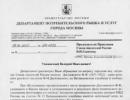Speech errors stringing cases examples. Mistakes in using parent subject and parent object. Stringing cases. See what "stringing cases" is in other dictionaries
Stringing indirect cases. Long chains of nouns in indirect cases (most often in the genitive) are one of the brightest and very unpleasant signs business style. The reason for this stylistic defect is usually the desire of the writer to express himself as formally as possible. To this end, the author avoids verbs, replacing them with verbal nouns.
At one time, K.I. ardently opposed the dominance of verbal nouns and the stringing of cases. Chukovsky. About the author of heavy and unintelligible verbal constructions, he wrote:
“He still does not know the elementary rule forbidding such long chains of genitives: "The House of the Doctor's Brother's Coachman's Wife's Nephew".
With the creative stationery style, the situation is even worse. It would seem, how not to remember the mockery of this creative, which is so often found among old writers.
From Pisemsky: "Inflight and breaking glasses by a crow ..."
From Herzen: "Gnawing the plan thereof by mice ...". *
* Chukovsky K.I. Live like life // Chukovsky K.I. Op. in 2 volumes - T. 1. - M., 1990, p. 592.
It is necessary to avoid such constructions: they are not always funny, but in all cases, without exception, obscure the meaning of the text. The editor is obliged to ruthlessly cross out chains of nouns in indirect cases, replacing heavy and unintelligible constructions with verbs, changing the structure of the sentence.
Not properly: "In order to fulfill the requirement to improve the quality of education...".
Correctly: "In order to improve the quality of education...".
Not properly: "We agreed with the decisions made by our colleagues."
Correctly: "We agreed with the decisions that our colleagues made."
Complex sentence structure . Sentences consisting of two or more parts, each of which has its own grammatical basis (subject and predicate or one of the main members), are called complex. Parts can be connected with the help of unions or only with the help of intonation. In written text, parts of a complex sentence are usually separated by a comma or other punctuation marks.
The official style is characterized by the use of a large number of complex sentences, especially complex ones, i.e. those in which one of the parts is the main one, the other is subordinate (dependent). In the documentation it is impossible to do without subordinating constructions with clauses of time ("After the letter is received, we will take action..." etc.), conditions (“If obligations are not met, we will apply penalties ...” etc.), goals (“It is proposed to consider the issue at the presidium in order to develop common point vision..." etc.), etc.
In many cases, it is preferable to use complex sentences, and not constructions with participial and participle turnovers. This helps to avoid such a serious disease of the clerical style as "voicelessness". As noted above, it is the lack of verbs that leads to the "stringing" of indirect cases (“discussing the improvement of the conduct of events”), makes speech heavy, complicates understanding. Often, replacing a participle or participle with a subordinate clause gives the writer the opportunity to return the verb to the text, to give the message clarity and dynamics.
Compare offers:
“The reference analyzes the processes taking place in industries equipped with modern equipment.”
“The reference analyzes the processes that take place in industries equipped with modern equipment.”
In the first case, two participial phrases follow each other and make it difficult to understand the text. In the second, the combination of the attributive clause with the allied word "which" and the participial turnover gives the sentence the necessary grammatical diversity, makes the content clearer.
Complex sentences can be associated with certain difficulties. First of all, this grammatical tool, like any other, should not be abused. In official papers, very long sentences, including an endless chain of subordinate clauses, are inappropriate. The optimal design for business style is a complex sentence consisting of two parts.
In addition, it should be remembered that it is unacceptable to combine in one sentence as homogeneous members of participial or participial phrases and subordinate clauses.
Not properly: "The commission will have to identify the problems that have arisen in the course of work, and what measures can be taken to eliminate them."
Correctly: "The commission will have to identify the problems that have arisen in the course of the work, and determine what measures can be taken to eliminate them."
When using complex sentences, it is important to ensure that the subordinate clause relating to single word, combined with it lexically. Consider an example:
“We ask you to confirm the examination in your medical unit of the studentN, and also whether a certificate was issued to him.
Obviously, only one fact can be confirmed. Any construction with the union “li” does not imply a statement of fact, but a question and cannot be combined with the verb “confirm”.
Right option:
“We ask you to confirm the examination in your medical unit of student N, and also indicate whether a certificate was issued to him.”
Today, the documentary worker is placed at an advantage compared to his colleagues who worked in this field in previous decades. Modern electronic technology greatly facilitates the creation, processing, storage, and search for documents. The process of compiling and editing texts is being improved. However, it must be remembered that even the most advanced technology remains only a means in the hands of a person and cannot take on all his duties. So, spell checking is possible only within certain limits: proper names, abbreviations, purely special terminology - all this remains on the conscience of the author and editor of the text. The computer does not guarantee neither grammatical nor stylistic errors. That is why the professional requirements for a modern worker of the apparatus are both computer and language literacy.
View subordination, in which the main word requires a strictly defined case / prepositional case form from the dependent, is called control. There is a synonym for prepositional and non-prepositional constructions (interesting to everyone - interesting to everyone; his face turned red - his face turned red; go through the field - go through the field; return by train - return by train).
The genitive case of an object is the meaning of a noun in the genitive case, in which the object of the action is indicated (reading a book - reading a book; building a house - building a house). The genitive case of the subject is the meaning of a noun in the form of the genitive case, in which the subject of the action is indicated (the order of the boss - the boss ordered; the arrival of a friend - a friend arrived).
A stylistic mistake is the presence in one sentence of two words in the form of the genitive case, but with different meanings (the government's search for money to pay pensions) or the ambiguity, ambiguity of the sentence with the genitive case of the noun (handover of the hostages - did they pass? Did they pass? A letter from the mother - to her or from her). Ambiguity can also be caused by morphological homonymy of other case forms, such as the dative subject and the dative object (In this case, the Democrats should have given out literature for free. Did the Democrats hand out literature or were they handed out literature?)
The stringing of cases also belongs to the category of stylistic errors. The essence of this error is that several words in one case form are located in a chain, depending on each other: Students of training courses for assistant drivers of electric trains. The stringing of the genitive case is often observed. The stringing of the genitive case in many cases is not a stylistic mistake, but a structural element of business or scientific speech, in which verbal nouns are often found, suggesting the use of another noun dependent on it in the genitive case: Study of variants of synonymous constructions; Development of methods for the use of minerals in the coastal areas of the Ob River. The stringing of other cases is less common and only as a stylistic mistake: Filling cracks with foam by our craftsmen; Agreement on the agreement on netting payments.
The case of the controlled word depends on its part-of-speech affiliation.
If the dependent word is a noun, then gender. P.: proof of which
–proof of a theorem, proof of correctness; evidence of guilt.
If the dependent word is a demonstrative pronoun, then dat. P .: proof of which- the following facts serve as proof of this. BAS-2 qualifies this control as obsolete.
Cannot be combined in one sentence Genitive subject and parent object. The first one indicates the producer of the action ( Speaker's speech, arrival of the delegation), second – On the action object ( Reading a book, selecting illustrations). When corrected, the genitive subject is usually replaced by the instrumental: instead of: Sequential presentation of the lesson material by the student to tell: Consistent presentation by the student of the material of the lesson.
In some cases, ambiguity may arise when using even one genitive case: Reading Mayakovsky left an indelible impression (did the poet himself read or were his poems read?). For the first value, you can say: Mayakovsky reading his works...; For the second value: Reading Mayakovsky's poems...
At two or several homogeneous members a common controlled word is put only if the control words require the same case and preposition: Read and outline a book, write out and check quotes Etc.
Incorrect sentences are sentences in which there is a common object with words that require different management, for example: To love and be fond of poetry (To love What? Get involved How? ) .
Usually such sentences can be corrected by adding a pronoun to the second control word, replacing the noun object of the first word: love Poetry and enjoy it.
Receives development in the first years of Soviet power. It is used in clerical and emotional speech.
definition
An arrangement in a chain, usually with sequential subordination, of several identical case forms. House of the nephew of the coachman's wife the doctor's brother(example of A. M. Peshkovsky). Most often there is a similar accumulation of forms of the genitive case. Creative processing of the image of the courtyard goes along the line of enhancing the display of the tragedy of his fate(example of K. I. Chukovsky). Stylistically, the neighborhood of even two forms of the genitive case is unfortunate, if one is formed by the genitive subject, and the other by the genitive object. Method of systematic and consistent presentation of the teacher educational material (example M. Shaginyan). It is also possible to string forms:
- creative case. The report was met with loud applause by the audience.. The issue will be considered by the commission appointed by the Directorate.. The trainer was raised by an elephant trunk. Are you unhappy with me.
- dative case. Start preparing for exams. Strive to complete on time.
- prepositional case. Talked about the discussion about working methods. Discussed the issue of an agreement on mutual assistance.
G. O. Vinokur connects the stringing of cases with “an extraordinary spread of nouns at the expense of the verb in such cases when our stylistic skills would require syntactic subordination, that is, a“ subordinate clause ”, and where this sentence is replaced by a verbless construction”: 103. G. O. Vinokur discovers in the language of the first years Soviet power noun hypertrophy and verbosity:
Such typical cases as: “did not receive the radio due to throwing”, or: “in the absence of help, the eating of seed reserves will follow - will show what I mean by this hypertrophy of nouns and speechlessness. Such constructions are now very common ...
Most of the examples here are verbal nouns ending in "-anis", "-enie"; somewhat less - on “-atie”, etc. For example: growing up, interpreting, intriguing, covering up, trampling, tying; almost anecdotally sounding - “spreading oneself on the ground” (in “The Atheist”) or: “due to the postponement of the process” (in Izvestia). On the other hand, this also includes a number of words that are essentially familiar, but receive an unusual syntactic coloring from the addition of a negation to them. These are non-receipt, non-acceptance (“failure to take precautions”), non-recognition (“the fact of recognition or non-recognition”), non-use, non-punishment, etc. The following case is also interesting: “the British ambassador had a long conversation with Hughes about the non-ratification of the Washington Treaty by France on disarmament." I will also note a case where the word “-en” in itself is not unusual, but inaccurately used, due to which this case also belongs to the category of facts described: “The monotony of work entails a significant increase in fatigue” (instead of: fatigue or fatigue). Finally, one more example of the deliberate hypertrophy of names at the expense of the verb: "to avoid the impossibility of the state accepting these colossal amounts of bread."
I think that I will not be mistaken if I assume here the influence of the clerical language, the mechanics of which so many have become familiar with during the years of the revolution. The very form of construction indicates this influence. Who does not know that in clerical language, as often as in newspaper language, there is a rule: you cannot use “what”, “which”, etc. words twice in the same period. And since periods are long, this syntactic regulation leads to the situation when “the only salvation” is in such words as “eating”, “mixing” or “spreading”, and when it appears - “avoiding the impossibility of acceptance”. And it is this obvious influence of the clerical language that allows us to once again point out the same basic trend that characterizes the development of the "language of NEP". After all, the clerical language is a rudiment of the culture of the language, this is the first attempt of a person to master the language element, to subjugate all these disobedient particles, conjunctions, pronouns that do not fit into a harmonious, smooth period. In any case, we have a clear attempt to build our speech in accordance with the specific skills of writing: 103-105.
examples
Complex combinations- Council for the Promotion of Strengthening Interethnic Accord and Peace(Bashkiria).
in slogans
- The most important, most responsible task of party propaganda is the organization of a nationwide study of the decisions of the XVIII Congress of the CPSU (b) (1939 , Marxism)
in emotional speech
Alexander Vvedensky uses case stringing in his emotional speech:
The revolution breaks not only the fetters of the monarchical chains of the oppression of the people, but also ruthlessly tears the inner chains, the nets in which proud and free human thought struggled painfully.
in the speech of the masters
Vvedensky Alexander Ivanovich, Zabolotsky Nikolai Anatolievich, Hilarion (Alfeev), Clement (Kapalin), Nicodemus (Rotov), Philip (Ryabykh), Khoruzhy Sergey Sergeevich
analogy
Stringing cases in the forefront:
Another characteristic for Kharms method of creating semantic ambiguity against the background of punctuation deviations is the injection of prepositional genitive constructions. We can reconstruct Kharms' conscious focus on such constructions not only in the analysis of his texts, but also in the analysis of manuscripts. For example, in the 1931 poem "Khnyu" we find the following verses:
sources
- Rosenthal D. E., Telenkova M. A. Dictionary-reference book of linguistic terms.. - 2nd. - M.: Enlightenment, 1976.
Footnotes
- Vinokur G. O. The language of life. The language of "NEP" // Culture of the language / Pred. text by I. V. Peshkov. - M.: Labyrinth, 2006. - 256 p. - (Philological Library). - ISBN 5-87604-077-0.
- See V. Chernyshev. Correctness and purity of Russian speech, 3rd ed., S. 259.
- Kirill (Gundyaev), Met.
Among the stylistic shortcomings is the so-called stringing of cases, i.e. the arrangement of a chain of several identical case forms. Such a cluster of cases makes it difficult to understand the phrase, for example: The house of the nephew of the coachman's wife, the doctor's brother (example of A.M.
Peshkovsky). Most often, stringing of genitive cases occurs due to the high prevalence of the genitive adjective. Here are a few examples: “In order to further improve the cause of raising the ideological and theoretical level ...”; "To solve the problem of accelerating the rise in the level of agriculture ..."; “Creative processing of the image of the courtyard goes along the line of enhancing the display of the tragedy of his fate” (example of K. Chukovsky); “Concrete measures are planned to fulfill the requirement to eliminate the backlog in the production of parts.” Saving such texts is unacceptable. When editing, verbal nouns are usually (see § 125) replaced by infinitives or other constructions, common turns - subordinate clauses etc.; for example, instead of the first phrase when editing, we will write: To increase the ideological and theoretical level ...; instead of the second - To accelerate the rise of agriculture ... Sometimes it is enough to “break” the chain of genitive cases in some place to make the text easier to perceive. A confluence of other identical cases is less common, but it is also possible, especially the stringing of instrumental cases, for example: “The issue will be resolved by the commission appointed by the directorate”; “It was impossible to confine ourselves to the decisions made by the students”; "The speech was greeted by the guests with loud applause"; "The hunters admired the moonlit clearing"; “Martenovka also made its contribution to the process of mastering the culture of the personnel of the plant”; “Antipov was elected chairman of the local committee for the second time”; “You are dissatisfied with something with me”; "Conversation with a student who came unprepared"; "He was raised by an elephant's trunk", etc. The same with other cases, for example: “We started preparing for the competition”; “The question of an agreement on mutual assistance was discussed at the conference,” etc. You can correct the texts as follows: The issue will be decided by a commission appointed by the directorate; It was impossible to limit ourselves to the decisions that the students made; A conversation with a student who came to the exam unprepared; The conference discussed an agreement on mutual assistance; The elephant picked it up with its trunk, and so on. Case forms with the same prepositions should also be avoided, for example: “We talked with an engineer with a long production experience” (instead of ... having a long production experience); “The Komsomol Bureau has drawn up an appeal to the youth of the plant striving for knowledge” (instead of ... to the youth striving to gain knowledge). The combination of homonymous forms such as the mother loves the daughter, the sea reflects the sky, the leaves cover the trees, etc., is also unsuccessful, since in such cases an ambiguity is created or the understanding of the sentence is difficult (see § 89). A combination of a genitive subject and a genitive object in one sentence is not allowed. The first is understood as the genitive case, denoting the subject of the action, for example: the arrival of a brother, the performance of artists; the second genitive indicates the object of the action, for example: reading a manuscript, editing a text. The presence of both genitives in the same sentence leads to stylistic errors, for example: “The story “The Steppe” is the result of Chekhov’s complex search for his creative manner”; "AT. Alpatov dwelled on some of the latest medical assessments of the impact of tobacco, alcohol, diet, and vitamins on the human body”; L. also disagreed. Chukovskaya and with D. Eremin's assessment of the stories of A. Yashin and N. Zhdanov”; “With the release of the two-volume book, Soviet readers will be able to reacquaint themselves with the talented sketches of the heroic everyday life of our people by such writers as M. Koltsov, Larisa Reisner, A. Agranovsky, A. Todorsky, and many others”; "Pushkin's search for new means and techniques of artistic expression"; "Dobrolyubov's assessment of the 'dark kingdom'". Wed See also: The principle of activity and consciousness of mastering the knowledge of students; The method of systematic and consistent presentation of the teacher's educational material (examples M. Shaginyan). In these cases, the correction of the text is usually achieved by replacing the genitive subject with the instrumental. Thus, in the last sentences cited above, instead of Dobrolyubov's estimate, we would say Dobrolyubov's estimate; instead of assimilation of knowledge by students - assimilation of knowledge by students, instead of presentation by the teacher - presentation by the teacher. In some cases, ambiguity or ambiguity may arise when using even one genitive case, for example in nominal sentences: "The return of the children" (did they return themselves or were they returned?); or in such sentences: “The check of the local committee showed ...” (did the local committee check or was it checked?); “The characteristic of the headman was positive” (the headman gave a characteristic or was he characterized?), etc. Editing such sentences consists in replacing the parent object or subject with another construction, for example: Check carried out by the local committee ...; Characteristics issued by the headman ... - issued to the headman ... As for sentences-headings, lexical replacement, distribution in other words, etc. is possible in them.
→ → → case stringing in the Dictionary of Linguistic Terms
stringing cases is
case stringing
An arrangement in a chain, usually with sequential subordination, of several identical case forms. The house of the nephew of the coachman's wife, the doctor's brother (an example of A. M. Peshkovsky). Most often there is a similar accumulation of forms of the genitive case. The creative processing of the image of the courtyard goes along the line of enhancing the display of the tragedy of his fate (an example of K. I. Chukovsky). Stylistically, the neighborhood of even two forms of the genitive case is unfortunate, if one is formed by the genitive subject, and the other by the genitive object. The method of systematic and consistent presentation of the teacher's educational material (example M. Shaginyan). It is also possible to string forms:
a) instrumental case. The report was met with loud applause by the audience. The issue will be considered by the commission appointed by the directorate. The trainer was raised by an elephant trunk. You are dissatisfied with me.
b) dative case. Start preparing for exams. Strive to complete by the deadline.
c) prepositional case. He spoke about the discussion about working methods. The question of an agreement on mutual assistance was discussed.
Dictionary-reference book of linguistic terms. Ed. 2nd. - M.: Enlightenment.
Rosenthal D. E., Telenkova M. A..
Page Links
- Direct link: http://website/lingvistic/796/;
- Link HTML code: What does stringing of cases mean in the Dictionary of Linguistic Terms;
- Link BB code: Definition of case stringing in the Dictionary of Linguistic Terms.






